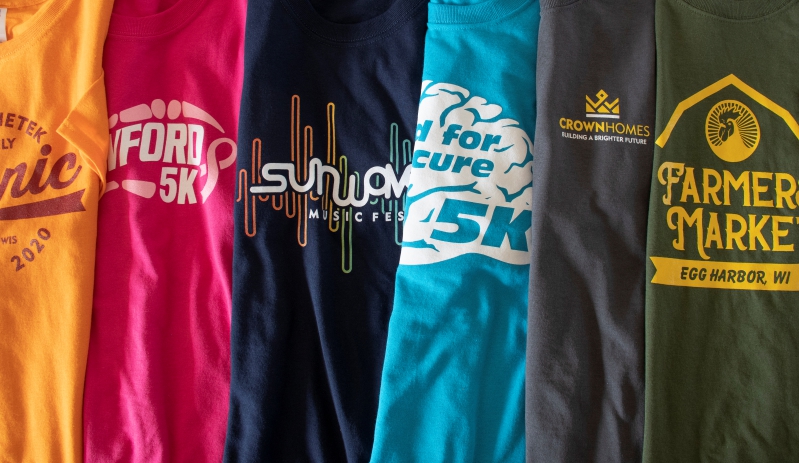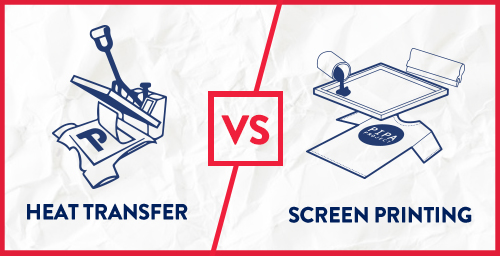The Basic Principles Of Tx Tees
The Basic Principles Of Tx Tees
Blog Article
Getting My Tx Tees To Work
Table of ContentsWhat Does Tx Tees Mean?Tx Tees - An Overview8 Simple Techniques For Tx TeesSome Known Facts About Tx Tees.Some Known Facts About Tx Tees.Facts About Tx Tees UncoveredNot known Facts About Tx Tees
Add up other prices, like the number of utilities it takes to run the store and the expense of ink and emulsion per design. Take the print listed below.The solution ought to just be a couple of cents because you 'd just require to coat one screen for this task. So just how much should you bill per shirt to earn a profit? Generally, printers try to make up to 45% earnings on a print work. Here's a table to assist you establish that: total cost per product percent of wanted earnings as a decimal (instance:.25 or.45) profit made per product per task Currently allowed's talk about the earnings of DTF.

With DTF, you can print a handful of t-shirts, or simply one. Both screen printing and DTF have their niches in the globe.
The Tx Tees Diaries
The finest way to recognize? Ask around and see what printing shop like your own are doing. custom screen printing. Try both out and see which you like much better
When you're choosing what sort of printing approach to use for printing your art work designs on your garments, it is very important that you understand the distinctions in between these two methods so you can make the most of outcomes while decreasing costs. Screen printing is the most frequently made use of strategy for printing designs on textiles.
DTG printing is also referred to as area or straight to garment printing due to the fact that it publishes just what is required rather than making a screen as screen printers do. https://www.twitch.tv/txtees02/about. Display printing works by display filler squeegee display printing ink screen mesh display, then moving the picture to garment using warmth and/or pressure
The DTG printer makes use of special dye-sublimation inks that are applied right into a pre-designed photo by a digital printing system. The inks become component of the material, permitting lively colors and exceptional information. It's also referred to as area or straight to garment printing since it publishes only what is needed rather of making a screen as display printers do.
4 Easy Facts About Tx Tees Described
First, it's much quicker - you can publish a fullcolor image in minutes, in contrast to hours for screen printing. Second, there's no established up time or prices involved - you can print any type of layout you such as, without having to create a screen. Third, there's no waste - since screen printers display print one style at once, they need to evaluate each color separately.
The paper is extremely costly and can just be made use of as soon as. Once it's published on, it needs to be disposed of. - The preliminary acquisition rate is reduced than the upfront investment of DTG printers- You can print multi-color styles one screen each time rather than needing to publish each shade independently like DTG printing.

Tx Tees for Dummies
Nonetheless, as opposed to making use of screen mesh as display printers do, dye sublimation printers utilize laser modern technology to move your pictures onto garments or paper. A heat procedure moves the dye from its solid-state straight right into the gas phase which consequently integrates it onto fabric substratums when they are swiftly heated to heats under high stress.
Sublimation printing is green. It uses less water than screenprinting, and since it does not involve using harmful solvents, it's safe for all kinds of garments. The dye sublimation inks are also unsmelling when cured, unlike screen printers that utilize unsafe chemicals during the screen printing process that leave an undesirable odor.
They also save cash on expensive tools like exposure systems given that color sublimation printers don't require a UV exposure system or a flash remedy stove that is typically utilized in screen printing (custom monograming). What is direct to garment printing (DTG Printing)? DTG printing is a digital screenprinting process that prints straight onto textile using specialized inkjet printers
Everything about Tx Tees
DTG printing offers several advantages over standard screenprinting, including the ability to print photo high quality pictures, higher color vibrancy, and the ability to publish designs on darker fabrics. DTG printers function by heating up the fabric ink till it turns into a gas. The gas after that permeates the fabric, bonding with the fibers to develop a permanent print.

Screen printers merely prepare their display then start printing up until they lack item or ink.- There is a wide variety of skilled screen printers all over the globe, which can be handy for newbies. - It's a slower procedure - display printers frequently have to wait for the ink to dry prior to they can publish the following shade- Screen printers need manual work, so there's a higher learning curve and it takes longer to generate a top quality design- Display printing isn't as exact as DTG printing, so you might get some "bleeding" of shades from one component of the picture onto another if not done effectively.
How Tx Tees can Save You Time, Stress, and Money.
Nevertheless, rather than utilizing screen mesh as display printers do, dye sublimation printers make use of laser technology to move your pictures onto garments or paper. A warm procedure see transfers the color from its solid-state directly right into the gas stage which consequently fuses it onto material substratums when they are quickly warmed to heats under high pressure.
Sublimation printing is environmentally friendly. It utilizes less water than screenprinting, and because it doesn't entail making use of harmful solvents, it's risk-free for all kinds of clothing. The color sublimation inks are also odor-free when healed, unlike screen printers that utilize harmful chemicals during the display printing procedure that leave behind an undesirable smell.
They also save cash on pricey equipment like direct exposure devices because color sublimation printers do not require a UV exposure system or a flash treatment stove that is generally utilized in display printing. What is straight to garment printing (DTG Printing)? DTG printing is a digital screenprinting process that prints directly onto material making use of specialized inkjet printers.
The Only Guide for Tx Tees
DTG printing offers numerous benefits over conventional screenprinting, including the capability to publish photographic high quality pictures, greater color vibrancy, and the ability to print designs on darker fabrics. DTG printers work by heating up the textile ink up until it transforms right into a gas. The gas after that penetrates the textile, bonding with the fibers to produce an irreversible print.
Report this page